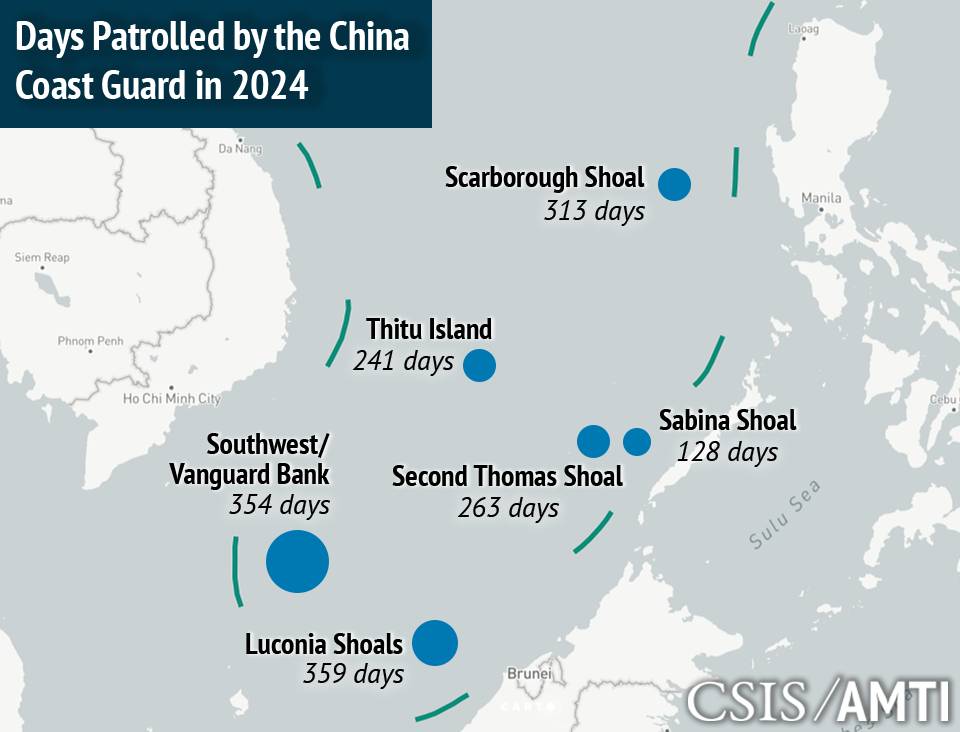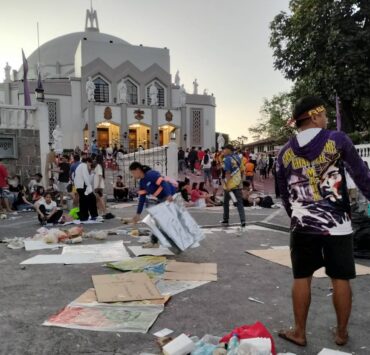Silence not an option amid China encroachment

With China aggressively insisting on the legality of its baseless nine, now 10-dash line, which covers almost the entire South China Sea, one can only imagine what a swarm of vessels could do to advance its occupation.
Based on latest data from the Asia Maritime Transparency Initiative (Amti) of the Center for Strategic and International Studies, China has kept a constant presence in the South China Sea in 2024, staying in other countries’ waters for 1,939 ship days.
Amti said this is longer than the previous record of 1,652 in 2023.
China’s vessels had stayed the longest in Luconia Shoals for 359 days and Vanguard Bank for 354 days. They were seen as well in Scarborough (Panatag) Shoal for 313 days, Second Thomas (Ayungin) Shoal for 263 days, Thitu (Pag-asa) Island for 241 days and Sabina (Escoda) Shoal for 128 days.
As pointed out by Amti, the China Coast Guard “is as active as ever in patrolling every corner of its vast claim in the South China Sea,” which has parts that fall within the exclusive economic zones (EEZs) of several countries.
The Philippines has protested this, especially China’s aggression against Filipino vessels which has endangered Philippine Navy and Philippine Coast Guard personnel.
Vietnam broke its silence, too, as it demanded the release of its fishermen and vessels believed to have been illegally captured by the Chinese off the Paracel Islands, where it has conflicting claims with China and Taiwan.
Even with China’s presence in Luconia Shoals, Malaysia said it would still proceed with oil and gas exploration within its EEZ, including the activities at the Kasawari Gas Development Project off Sarawak in Malaysia Borneo.
China’s constant response has been its actions are legitimate, saying that all other states asserting their respective rights over parts of the South China Sea “infringe” on its sovereignty even though it only has the nine, now 10-dash line as basis. The dashed line has already been invalidated by an arbitral court in 2016.
International relations analyst Dr. Elaine Tolentino noted earlier that “no amount of diplomacy [seems to be] working to prevent China from its ambitious claims in the South China Sea.”
“It does it simply because it can,” she told Inquirer.net.
Chinese outposts
Based on a list by Amti, China has 20 outposts in the Paracel Islands and seven in the Spratlys. In a bid to legitimize all of these, China is believed to be taking a grip of strategic features in the South China Sea.
As early as 2017, then Supreme Court Associate Justice Antonio Carpio said Sandy Cay, a sandbar close to Thitu or Pag-asa Island which is occupied by the Philippines, was “being seized” or “being invaded” by China.
But then President Rodrigo Duterte at that time downplayed the allegation, saying there is no need to fight over a sandbar. “China assured me that they will not build anything there,” he had said.
Meanwhile Dr. Jonathan Anticamara, a professor from the Institute of Biology of the University of the Philippines, found “rubble piled on Pag-asa Cays 1, 2 and 3 [which] are now exposed even in high tide.”
Pag-asa Cay 2 is Sandy Cay, which is now above water at high tide and is entitled to a 22-kilometer (12-nautical-mile) territorial sea designation, which is the sovereign territory of a state, maritime policy analyst Dr. Mark Valencia had said in an analysis published in 2019.
While Anticamara said there is still a certain degree of uncertainty as to how rubble piled up on the sandbar, National Task Force for the West Philippine Sea spokesperson Jay Tarriela said “there is no other country that we can pinpoint” as a “suspect.”
“It’s only the People’s Republic of China,” he said.
Strategic sandbar
In 2022, a Bloomberg report said China had been carrying out reclamation at some features in the Spratlys—Sandy Cay, Lankiam Cay, Eldad Reef, and Whitsun Reef. China dismissed the report.
Anticamara said he is “not 100 percent certain” how the rubble piled up, but he observed something “weird or not common,” saying that the sandbar in Sandy Cay did not look like other islands that were naturally formed.
“When I went there, it seemed like there were still live corals that were piled with a lot of rubble that were so whitish and did not yet have algae that it looked like they were newly piled,” he told Inquirer.net in a recent interview.
As pointed out in The Maritime Review, Sandy Cay is small yet “its value is tremendous” from a legal perspective, as it is classified as a rock that can generate a territorial sea where a state can assert sovereignty.
Valencia noted that “given the sweeping claims to parts of the South China Sea, ordinarily a dispute over the ownership of a sandbar would not be a big deal.”
But Sandy Cay is strategic. “It so happens that the sovereign of these sandbars would significantly enhance its strategic and legal position in the area, especially since sovereignty over a territorial sea extends to the airspace, seabed and all associated resources.”
As stated in The Maritime Review, if Sandy Cay did not exist or there were no high-tide features in Thitu Reef’s western atoll, demonstrating sovereignty over Thitu Island would suffice to gain a claim to Subi Reef, which is occupied by China.
To bolster its claim over Subi Reef, where a 394-hectare artificial island has been created with a three-kilometer military grade runway and a seaport, China has to demonstrate sovereignty over Sandy Cay.
China-Malaysia dispute
The Philippines, conversely, has to exercise sovereignty over Sandy Cay to claim Subi Reef and extinguish any legal ground for China’s occupation and construction of an artificial island on the feature.
Valencia explained that the stand of the Philippines is that China’s sovereignty claim to Subi is invalid and that it lies within its EEZ and on its continental shelf. The problem, however, is Subi Reef lies within the 22-km territorial sea of Sandy Cay.
This is not an exclusive concern of the Philippines, as sandbars seem to be coming to sight permanently in Luconia Shoals, site of Malaysia’s Kasawari project.
Since 1963, Malaysia has exercised sovereignty over Luconia Shoals, and in 1974, it incorporated state-owned energy company Petronas and vested in it the right to explore and produce oil and gas.
China, however, stated in a two-page diplomatic note in 2024 that the oil and gas exploration “infringes” on China’s sovereignty over both the north and south Luconia Shoals, where the Luconia and Seahorse Breakers are located.
The Luconia Shoals are over 704 km (380 nautical miles) away from China-occupied Fiery Cross Reef.
‘Power illusion’
From July 2022 to February 2025, the Philippine government had filed 203 diplomatic protests against China.
Defense analyst Chester Cabalza, president of think tank International Development and Security Cooperation, maintained that “point blank diplomatic protests against China are still effective, [but] it should evolve to diplomatic dialogue to resolve problems.”
The Philippines’ National Security Council cited public support for the government’s stand on the West Philippine Sea, with 91 percent of Filipinos aware of the maritime dispute with China and 84 percent backing the government’s efforts to defend the area.
Cabalza told Inquirer.net that China and the Philippines as well as other claimant states must be “open [to] more critical and frank communication to find solutions in the big puzzle of strategic contestations.”
Because China’s bullying strategies have worked for its expansionist goals without resulting in actual conflict, as defense analyst Elaine Toletino had pointed out, the Philippines “should creatively find ways to impose actual costs on China that would question its power illusion that it is, at the moment, uncontested in its grey zone tactics.”
A longer version of this story appears on Inquirer.net.





















